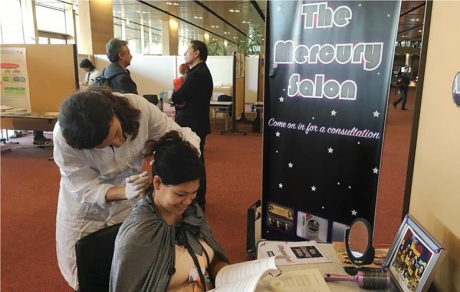Background:
In September 2017, researchers from IPEN (a global public health and environment network) invited delegates attending the first Conference of the Parties (COP 1) of the Minamata Convention on Mercury to volunteer to have hair samples taken and analyzed for total mercury concentration (THg). The methodology and sampling protocols for this survey were developed by IPEN and the Biodiversity Research Institute (BRI) in consultation with UN Environment. The methodology was employed in two recent studies. The first — Mercury Monitoring of Women of Child- Bearing Age in the Asia and the Pacific Region (IPEN/BRI/ UN Environment 2017) — focused on the Asia-Pacific region, and a subsequent global sampling study — Mercury in Women of Child-Bearing Age in 25 Countries (IPEN/BRI 2017) — included countries in additional regions.
 Photo: Delegates at the signing of the Minamata Convention to limit mercury pollution had hair samples take for testing (©
IPEN)
Photo: Delegates at the signing of the Minamata Convention to limit mercury pollution had hair samples take for testing (©
IPEN)
The new study:The results of this sampling campaign has now been published within a report entitled: "Mercury in Minamata Convention COP1 Delegates". As for previous studies, the delegate hair samples were analyzed at the laboratory of the BRI, a globally renowned research group specializing in mercury bio-monitoring. In total, 180 delegates (104 women and 76 men) from 75 countries agreed to have their hair samples analyzed for mercury. The results have been compared to the US National Research Council mercury reference dose of 1000 μg /kg m (1 ppm). The basis for the use of this reference level in this study is that it corresponds closely with the U.S. Environmental Protection Agency’s (EPA’s) reference dose (RfD) of 0.1 μg/kg bw/day and a blood mercury concentration of 4 - 5 μg/L. This level (approximately 1 ppm Hg as measured in hair) is the threshold above which the health impacts of mercury are known to occur in men, women and children.
Mercury was detected in all delegates. The results reveal that more than half of all delegates that provided hair samples exceeded the threshold level of 1 ppm. Delegates from Western Europe and Latin America and the Caribbean (GRULAC) had similar rates of exposure, with 42% and 47% (respectively) exceeding the safe threshold. In the Africa region, 52% of delegates were over 1 ppm, and JUSCANZ (Australia, Canada, Iceland, Israel, Japan, Liechtenstein, New Zealand, Norway, Switzerland, and the United States) results were even higher, with 60% exceeding 1 ppm. The Asia-Pacific region had the most elevated results, with 65% of delegates exceeding the threshold of 1 ppm.
The results demonstrate that no region of the world where delegates live is protected from mercury exposure. Delegates, as a group, have a high level of knowledge about mercury pollution sources. However, this knowledge is not sufficient protection against mercury contamination. Mercury exposure can occur from many sources; however, the primary form of exposure for most people is diet.
This survey of delegate mercury body burden serves to highlight that mercury pollution can affect people from all parts of the world and that exposure may be due to a combination of sources. The researchers conclude that it is critically important that delegates work together at future Mercury Treaty COPs to ensure strong measures are taken to eliminate mercury pollution from priority sources such as coal-fired power stations, small-scale gold mining and contaminated sites.
Source:
IPEN
 The original study
The original study
Lee Bell, David Evers, Sarah Johnson, Kevin Regan, Joe DiGangi, Jennifer Federico, Bjorn Beeler, Laura Vyda, Tiffany Tool, Emily Boone, Jitka Strakova, Jan Samanek,
Mercury in Minamata Convention COP1 Delegates, IPEN/BRI Report, November 2017. available at:
http://ipen.org/documents/mercury-cop1-delegates Related information
Related information

BRI (Oct. 2014) Patterns of global seafood mercury concentrations and their relationship with human health and the Environment.
DOI: 10.13140/RG.2.1.2558.0241
BRI (2011): Great Lakes Mercury Connections: The Extent and Effects of Mercury Pollution in the Great Lakes Region.
Available from ResearchGate
 Related EVISA News
Related EVISA News
last time modified: November 27, 2023